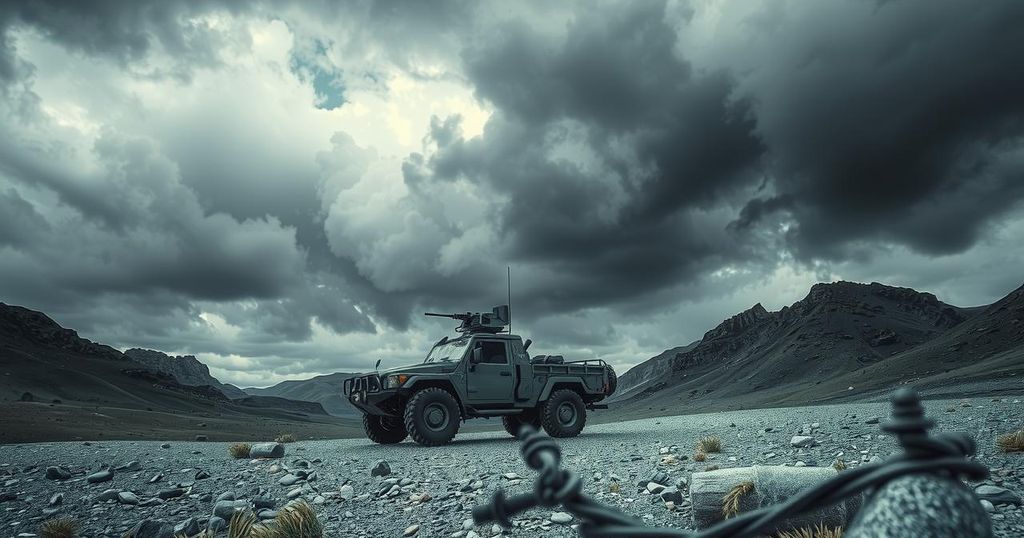The M23 group has intensified its control in Eastern DRC, threatening Goma’s stability with Rwandan military support and ongoing weaknesses within the Congolese army. This has led to significant civilian suffering and displacement, raising serious concerns about the potential for escalating violence and instability in the mineral-rich region.
The M23 armed group has gained further ground in Eastern Democratic Republic of Congo (DRC), now encroaching on the provincial capital, Goma. Experts suggest that the Congolese army’s weaknesses, along with Rwandan support, bolster the M23’s position. It is feared that an offensive on Goma, a city rich in minerals and resources, may be imminent after weeks of escalating hostilities between the M23 and the Congolese armed forces (FARDC).
Violence has led to significant humanitarian consequences, with hospitals overwhelmed and over 230,000 people displaced since January, as reported by the United Nations. The Congolese army has acknowledged the loss of Minova, a strategic trading town, to Rwandan soldiers and their M23 affiliates. A UN report has estimated the presence of 3,000 to 4,000 Rwandan troops directly supporting the M23, despite Rwanda’s official denial of aggression in the DRC.
Recent territorial gains by the M23 include the capture of Masisi, located approximately 80 kilometers northwest of Goma. Currently, the closest combat actions are occurring just 10 kilometers from Goma, threatening the city’s economy and stability. While the FARDC and allied militias strive to hold defensive positions, experts are skeptical about their capacity to withstand a potential M23 assault.
The UN peacekeeping force MONUSCO operates from Goma, yet its role in the event of the city falling remains uncertain. Notably, a recent peace process meeting involving Congolese President Felix Tshisekedi and Rwandan President Paul Kagame was canceled due to disagreements. “Nothing prevents the M23 and Rwanda from trying to take Goma,” remarks Reagan Miviri, indicating a bleak outlook for the region’s stability.
Expectations of geopolitical shifts linked to the potential return of Donald Trump to the presidency have also raised concerns about Rwanda’s future actions in the region. The DRC’s eastern provinces are rich in natural resources but remain vulnerable to violence from a multitude of armed factions since the civil wars of the 1990s. The M23, originating from a 2012 mutiny, poses a recurring threat after regaining strength and influence over the past two years.
Analysts note ongoing challenges for the Congolese military, such as corruption and low morale, significantly hampering their effectiveness against the M23. Despite operational support from Southern African Development Community troops from South Africa, Tanzania, and Malawi, their impact appears limited. With the situation deteriorating, additional international attention and intervention may be urgently needed to stabilize this conflict-ridden region.
The Democratic Republic of Congo has been grappling with prolonged conflicts for over three decades, characterized by the frequent emergence of armed groups like M23, which originated during a mutiny among former national army fighters. Coupled with a complex backdrop of political dynamics and international involvement, the region remains a hotspot for violence, primarily fueled by competition over abundant mineral resources. Recent developments indicate possible escalations in hostilities, particularly with perceived Rwandan backing of M23 fighters.
In conclusion, the situation in Eastern DRC is increasingly precarious as the M23 group consolidates power near Goma, amidst significant weaknesses within the Congolese armed forces. The influx of Rwandan military support complicates matters further, raising concerns about a potential offensive against an economically crucial city. As tensions rise and humanitarian crises deepen, international attention and strategic responses are imperative to address the ongoing conflict’s ramifications for the region and its inhabitants.
Original Source: www.barrons.com






